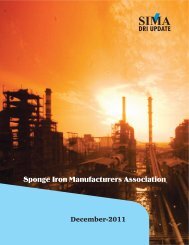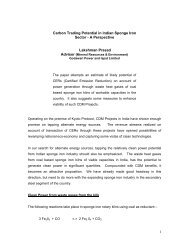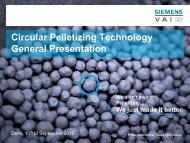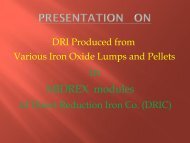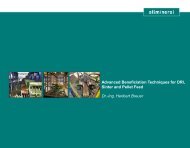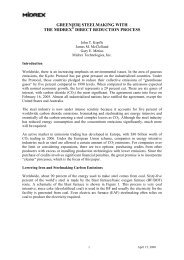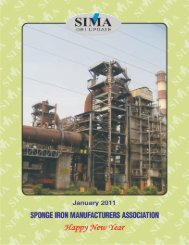Create successful ePaper yourself
Turn your PDF publications into a flip-book with our unique Google optimized e-Paper software.
S-L FBDB Gasification/MIDREX Plant can be<br />
paired with an EAF mill to produce high quality<br />
long or flat steel products<br />
Lower specific capital cost than blast furnace/<br />
BOF<br />
No coke, coke ovens, or sinter plant required<br />
Reduced air emissions: virtually no SOx or NOx<br />
compounds generated<br />
Ability to capture high purity CO2 for<br />
sequestering or injecting into oil and gas fields<br />
Much larger capacities than rotary kilns: up to 2<br />
Mtpy in a single module<br />
Better quality product than rotary kilns<br />
Midrex is now discussing the use of the S-L FBDB<br />
Gasifier/MIDREX combination with several Indian<br />
clients.<br />
FASTMET® and FASTMELT®<br />
Another possibility for iron production in India is rotary<br />
hearth furnace (RHF) technology. This includes the<br />
FASTMET and FASTMELT Processes. Developed<br />
by Midrex Technologies and its parent company<br />
Kobe Steel, Ltd., FASTMET uses a rotary hearth<br />
furnace to convert iron oxide fines and ferrous<br />
wastes into highly metallized DRI. Carbon in the form<br />
of coal or contained in the wastes is used as the<br />
reductant. Burners fired by natural gas or other<br />
hydrocarbons, plus combustion of volatiles, provide<br />
the heat required for the reactions. FASTMELT has<br />
the same flowsheet through the RHF and adds an<br />
electric ironmaking furnace (EIF®) to produce a high<br />
quality hot metal from hot FASTMET DRI. FASTMET<br />
and FASTMELT Plants can be built in capacities up<br />
to 500,000 tpy. A flowsheet is shown in Figure 4.<br />
The two technologies have different applications.<br />
FASTMET is primarily a means to recycle fine ironbearing<br />
materials such as blast furnace dusts and<br />
sludges, BOF dust, mill scale, and EAF baghouse<br />
dust. This greatly reduces the volume to be disposed<br />
of and produces a cost-effective iron product that<br />
can be melted in an electric arc furnace, BOF, or<br />
blast furnace. In the case of EAF dust, the zinc oxide<br />
recovered in the baghouse can be sold to a<br />
processor for production of metallic zinc. India has<br />
large volumes of steel mill wastes that could be<br />
effectively recycled in a FASTMET Plant. If there is<br />
not sufficient carbon contained in the wastes, a low<br />
volatile coal would be imported for use as the<br />
reductant.<br />
FASTMELT feeds iron ore fines and iron-bearing<br />
wastes and produces a blast furnacegrade hot<br />
metal. By controlling the DRI chemistry, the hot metal<br />
can be tailored to precisely match the desired<br />
chemistry for feeding to an EAF or BOF. FASTMELT<br />
hot metal can also be cast into pigs for sale or later<br />
use. India has several possibilities for iron ore feed,<br />
including screenings from pellet plants and other<br />
facilities, and blue dust. FASTMELT requires use of<br />
a low volatile, low ash coal that would most likely be<br />
imported.<br />
Figure 4<br />
FASTMELT Flowsheet<br />
The rotary hearth furnace used for FASTMET and<br />
FASTMELT has been well proven in operation since<br />
2000 at a significant scale. There are three<br />
FASTMET Plants operating in Japan, two of which<br />
feed over 200,000 tons per year of steel mill wastes.<br />
One of these plants is shown in Figure 5.<br />
MAY-<strong>2007</strong>/5



